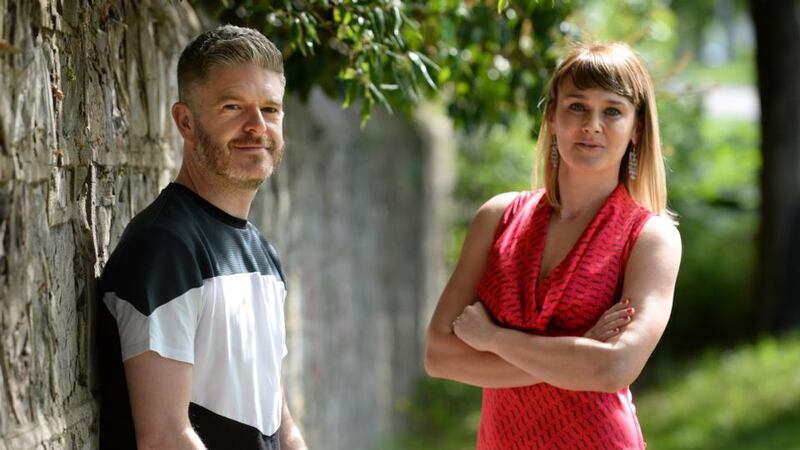There's a point during Riot, the Thisispopbaby production currently at Vicar Street in Dublin, that is somewhat transcendental. It involves a former Roscommon GAA player performing aerial choreography to a voiceover of Michael Harding ruminating on middle age, Apple tech-support call centres, love and mortality, while a tender and maudlin version of Justice's D.A.N.C.E. is sung.
The production, which debuted in the Spiegeltent at the Dublin Fringe Festival last year, is a barrage of spoken word, dance, circus, song, comedy and theatre. It isn't just good, or entertaining, or uplifting, or fun: it's a release. Riot is buzzed about because among a general absence of contemporary art on this scale reflecting who we are, it comes to the rescue. It sees us and nods in recognition. It sees Ireland and celebrates it as much as it interrogates it. It reflects a wildness and a kindness, and rejects blandness and self-importance.
Thisispopbaby are experts at creating shows for people who might not pore over the programmes of the Abbey or the Gate, but that sells what they do short, as if to say audiences should be segregated into theatre buffs and the rest of us. Indeed, their production Alice in Funderland filled the Abbey with an audience more than half of whom had never been there before. But the quality of the theatre they make isn't about "theatre for people who don't go", it's an invitation to see how good things can be once you get there.
Audience experience
When it comes to an audience experience, there is of course nothing worse than a bad play, primarily because you're trapped, silent, hostage to your new enemies in front of you. And, conversely, there is nothing better than a great production. The energy of submitting to that experience is another reason why Riot has taken hold, why it compels people to see it more than once, tell their friends and gush about it online.
Watching Riot, you realise that perhaps the central technical question Thisispopbaby – Jenny Jennings, Philly McMahon and co – are constantly asking is how can fantasy be rooted in realism, and realism in fantasy? Escapism plays a role, but the real escape is to ourselves, both in reflecting the "us" on stage, and asking us what can we do to make our worlds – homes, communities, streets, cities, countries, continents – better?
The feeling of recognition that pop culture can spark – particularly Irish pop culture, which is soaked in kitsch, surrealism and a fascination with outsiders – is a massive leveller. Riot operates on multiple levels of cultural shorthand while pulling that elusive trick: making something so very clearly of a place and a time that is also universal. People often wonder whether certain Irish productions could travel, while forgetting our greatest success are due to their intrinsic Irishness, from Joyce to Keyes and Binchy, Riverdance to Father Ted.

That feeling of recognition erases the cliched and fabricated silos we’re told divide us that exist in the imagination of soundbites. Most people don’t feel like they belong to the tribes of “middle Ireland” or “the establishment” or “the left” or “millennials” or whatever you’re having yourself. Even though many of us spend our lives wondering if we’ll fit in somewhere or truly belong, the truth is that most of us feel outside of the structures we’re told form the foundations of whatever fitting in is. We are often more strongly linked by our outsiderness, and our rejection of an imaginary mainstream.
Home
But, for many, the one true feeling of belonging – whether you want it or not – is that of place. A tie to home that some find security and comfort in, and others find strangling.
It’s hard to identify with the Ireland that lives within so much of our theatrical canon because it no longer exists. Yet a good deal of theatre seeks to recreate a version of Ireland that is a facsimile of past interpretations. It’s an Ireland that feels opaque and often literally misty, an Ireland that’s odd and distant, malevolent and depressing. It’s not that it’s an artefact, but perhaps an easy default. That version of Ireland is the setting for the downtrodden and sombre characters that live in so many films and novels, plays and poems. Sometimes that tone succeeds, a lot of the time negativity acts as a substitute for real feelings.
Riot snaps Ireland into colour. It is not blindly optimistic. It places resistance and egalitarianism front and centre. Even though it is in opposition to the dominant "turning a corner" narrative, it's still uplifting.
At a time when fuming and rage seem to be the default fuel for propelling so many conversations, Panti calls for kindness and empathy to be our prominent settings. At a time when "creatives" are increasingly entwined with corporations and brands, Emmet Kirwan calls for the artist to be a dissonant and disruptive. At a time of nihilism, it can be tear-jerkingly passionate. At a time of despair it reinvigorates hope as an option. At a time where people are shouted down, it is gentle. At a time when we are constantly told to expect the worst, it imagines the best. Art can be a salve, and sometimes having fun is a revolutionary act.









